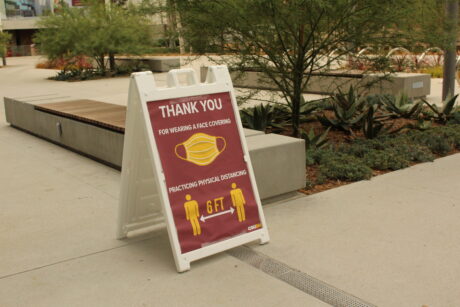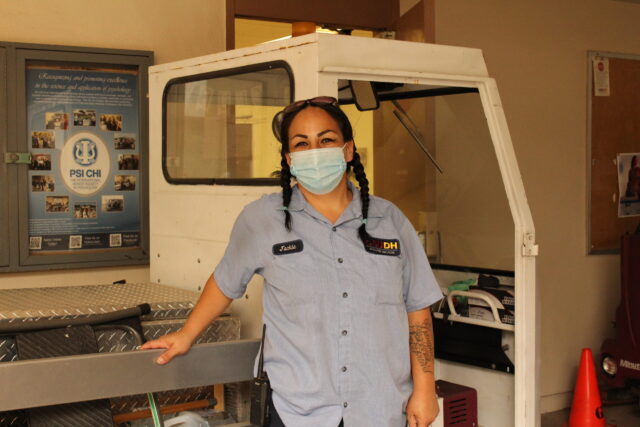Custodian Jackie Thomas makes student safety a priority, and does it with a (masked) smile. Photo by Raven Brown.
By Raven Brown, Staff Reporter
Handwashing, mask-wearing, sanitizing, social distancing and constant disinfection. COVID-19 has changed the way the world functions and the California State University, Dominguez Hills campus is no different.
With only 4 percent of the student body allowed to attend in-person classes this semester, CSUDH is sparing no effort in the fight against the coronavirus. In this first phase of having some students return to campus, the school’s custodial and nursing staff have both established stringent protocols to ensure safety for students, staff and faculty.
“Before each in-person class, we have 30 minutes to clean and disinfect the rooms completely,” Jackie Thomas, a CSUDH custodian, said. “We make our rounds to every class being used and I have to make sure every surface is sanitized and safe for the next students coming in.”
Thomas said that one of the buildings being cleaned the most frequently is LaCorte Hall, which is where art students who need access to kilns and other resources attend classes. Throughout these higher-traffic areas, hand sanitizer dispensers have been placed per orders of the Los Angeles County Department of Public Health.
According to the COVID-19 Response and Safety Plan, CSUDH has placed signage all around campus to alert the Toro community of the new safety procedures and cleanliness protocols.

These signs include reminders for face coverings, social distancing, minimizing touching of shared surfaces and arrows to ensure one-way traffic throughout buildings and walkways.
In addition, the bathrooms on campus are now referred to as “single-use bathrooms,” meaning that only one person can enter at a time. These facilities are being cleaned routinely throughout the day in addition to classrooms, offices, hallways and lobby areas.
Custodial services is part of the department of Facilities Services, which is within the Division of Administration and Finance.
In typical semesters, custodial services cleans approximately 1 million square feet of building space, according to the Facilities Services website.
Although there are far fewer bodies on campus this semester, those that are here are important enough that the number of custodial service employees had not been cut, Thomas said. Since Aug. 10, it’s been fully staffed with about 35 employees, most of whom work 8-hour shifts.
Under normal circumstances, custodial services operates from 4 a.m. to 10 p.m., meaning somewhere on campus there is usually someone cleaning something. However, shifts are staggered so that more highly trafficked areas can be cleaned with the least amount of interference with the daily school cycle.
As a result, many students may not notice the people doing the work that benefits everyone,but no one likes to think about.
But they notice us–and not just because of any messes we might leave behind for them to clean.
“It might seem weird, but I miss the students,” Thomas said. “There’s nobody around. It’s frustrating.”
But maybe the lack of people on campus makes those who are there pay a little more attention to each other.
“I’ve gotten a lot of thanks you’s for being here, and it’s nice to hear that,” Thomas said. “It’s nice to see that younger people pay attention [like] that.”
Student Health Center Also Operating
One of the few campus organizations that is operational this semester is also essential to health safety, the Student Health Center (SHC).
It has also increased its disinfection measures, implementing a facility-wide infection control program. While the measures were in place prior to COVID-19, they are now enhanced with the focus on more frequent cleaning and modified clinic hours to ensure the safety of patients.
Charge nurse Natalie Ashe is a part of a team of health professionals with the SHC that oversees the cleanliness and sanitization of patient care and staff areas. To reduce the risk of infection, only 10-15 students are allowed to be seen per day for non-COVID related visits.
“It takes about 5-15 minutes to clean the treatment rooms in between patients,” Ashe said. “This includes the drying time of the sanitizing solution, which is when the actual killing of germs on surfaces happens.”
The nurses are responsible for minute-to-minute sanitization, Ashe explained, but the custodial services also come in and clean before the staff arrives and throughout the day if necessary.
The SHC is operating with limited hours. For more information, call (310) 243-3629, or visit www.csudh.edu/together.

